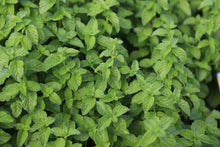
Spearmint, also known as garden mint, common mint, lamb mint and mackerel mint, is a species of mint, Mentha spicata, native to Europe and southern temperate Asia, extending from France in the west to southern China in the east. It is naturalized in many other temperate parts of the world, including northern and southern Africa, North America and South America. It is used as a flavouring in food and herbal teas. The aromatic oil, called oil of spearmint, is also used as a flavoring and sometimes as a scent.
The species and its subspecies have many synonyms, including Mentha crispa, Mentha crispata and Mentha viridis.
pearmint is a perennial herbaceous plant. It is 30–100 cm (12–39 in) tall, with variably hairless to hairy stems and foliage, and a wide-spreading fleshy underground rhizome from which it grows. The leaves are 5–9 cm (2–3+1⁄2 in) long and 1.5–3 cm (1⁄2–1+1⁄4 in) broad, with a serrated margin. The stem is square-shaped, a defining characteristic of the mint family of herbs. Spearmint produces flowers in slender spikes, each flower pink or white in colour, 2.5–3 mm (0.098–0.118 in) long, and broad. Spearmint flowers in the summer (from July to September in the northern hemisphere), and has relatively large seeds, which measure 0.62–0.90 mm (0.024–0.035 in). The name 'spear' mint derives from the pointed leaf tips.
Mentha spicata varies considerably in leaf blade dimensions, the prominence of leaf veins, and pubescence.
Mention of spearmint dates back to at least the 1st century AD, with references from naturalist Pliny and mentions in the Bible. Further records show descriptions of mint in ancient mythology. Findings of early versions of toothpaste using mint in the 14th century suggest widespread domestication by this point. It was introduced into England through the Romans by the 5th century, and the "Father of British Botany", of the surname Turner, mentions mint as being good for the stomach. John Gerard's Herbal (1597) states that: "It is good against watering eyes and all manner of break outs on the head and sores. It is applied with salt to the biting of mad dogs," and that "They lay it on the stinging of wasps and bees with good success." He also mentions that "the smell rejoice the heart of man", for which cause they used to strew it in chambers and places of recreation, pleasure and repose, where feasts and banquets are made."
Spearmint is documented as being an important cash crop in Connecticut during the period of the American Revolution, at which time mint teas were noted as being a popular drink due to them not being taxed.
The species and its subspecies have many synonyms, including Mentha crispa, Mentha crispata and Mentha viridis.
pearmint is a perennial herbaceous plant. It is 30–100 cm (12–39 in) tall, with variably hairless to hairy stems and foliage, and a wide-spreading fleshy underground rhizome from which it grows. The leaves are 5–9 cm (2–3+1⁄2 in) long and 1.5–3 cm (1⁄2–1+1⁄4 in) broad, with a serrated margin. The stem is square-shaped, a defining characteristic of the mint family of herbs. Spearmint produces flowers in slender spikes, each flower pink or white in colour, 2.5–3 mm (0.098–0.118 in) long, and broad. Spearmint flowers in the summer (from July to September in the northern hemisphere), and has relatively large seeds, which measure 0.62–0.90 mm (0.024–0.035 in). The name 'spear' mint derives from the pointed leaf tips.
Mentha spicata varies considerably in leaf blade dimensions, the prominence of leaf veins, and pubescence.
Mention of spearmint dates back to at least the 1st century AD, with references from naturalist Pliny and mentions in the Bible. Further records show descriptions of mint in ancient mythology. Findings of early versions of toothpaste using mint in the 14th century suggest widespread domestication by this point. It was introduced into England through the Romans by the 5th century, and the "Father of British Botany", of the surname Turner, mentions mint as being good for the stomach. John Gerard's Herbal (1597) states that: "It is good against watering eyes and all manner of break outs on the head and sores. It is applied with salt to the biting of mad dogs," and that "They lay it on the stinging of wasps and bees with good success." He also mentions that "the smell rejoice the heart of man", for which cause they used to strew it in chambers and places of recreation, pleasure and repose, where feasts and banquets are made."
Spearmint is documented as being an important cash crop in Connecticut during the period of the American Revolution, at which time mint teas were noted as being a popular drink due to them not being taxed.
















